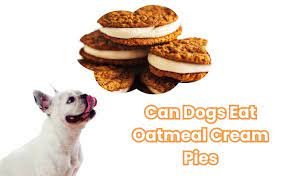Understanding if Dogs Can Eat Oatmeal Cream Pies:Is It Pawsible?

Welcome to “Canine Nutritional Needs Unleashed,” where we unleash the secrets to keeping our furry friends healthy and thriving. Dogs, with their boundless enthusiasm and unwavering loyalty, rely on a well-rounded diet to lead fulfilling lives.
In this adventure, we’ll uncover the essential nutrients vital for canine health and vitality. From protein to vitamins, fats to minerals, each component plays a crucial role in supporting our dogs’ overall well-being, ensuring they have the energy to chase balls and cuddle on the couch alike.
But let’s not forget about treats – those tantalizing delights that can make tails wag and eyes sparkle. While treats can be a wonderful addition to our dogs’ diets, it’s essential to understand their role in maintaining a balanced diet.
Join us as we dive into the significance of treats in providing mental stimulation, strengthening the bond between pet and owner, and rewarding good behavior. However, just like with any indulgence, moderation is key. We’ll explore the importance of moderation in treating consumption to prevent overindulgence and ensure our furry companions stay fit and healthy.
So, whether you’re a seasoned dog enthusiast or a newcomer to the world of pet ownership, let’s embark on this journey together. Together, we’ll unleash the secrets to meeting our dogs’ nutritional needs, keeping their tails wagging, and their hearts full of joy.So let’s know about –can dogs eat Oatmeal cream pies?
Investigating Oatmeal Cream Pies’ Ingredients:
Oatmeal cream pies typically consist of several ingredients, each contributing to the taste, texture, and overall composition of the treat. Let’s delve into the common components found in oatmeal cream pies, their nutritional breakdown, potential impacts on canine health, and identification of additives or preservatives that may be harmful to furry friends.
1. Components Commonly Found in Oatmeal Cream Pies:
- Oatmeal Cookies: These are typically made from ingredients such as oatmeal, flour, sugar, butter or vegetable oil, eggs, and leavening agents.
- Cream Filling: The filling usually contains ingredients like sugar, vegetable shortening, corn syrup, water, and flavorings to create a creamy texture and sweet taste.
2. Nutritional Breakdown and Potential Impacts on Canine Health:
- Caloric Density: Oatmeal cream pies are calorie-dense treats, with each pie containing around 230-270 calories. Excessive consumption can lead to weight gain and obesity in dogs.
- High Sugar Content: These treats are high in sugar, with approximately 15-20 grams per pie. Excessive sugar intake can contribute to dental issues, weight gain, and an increased risk of diabetes in dogs.
- Fat Content: Oatmeal cream pies contain significant amounts of fats, including saturated fats from ingredients like butter or vegetable shortening. High-fat diets can contribute to obesity, heart disease, and digestive issues in dogs.
3. Identification of Additives or Preservatives That May Be Harmful to Furry Friends:
- Artificial Flavors and Colors: These additives offer no nutritional benefit and may cause allergic reactions or digestive issues in some dogs.
- Preservatives: Chemical preservatives such as BHA, BHT, and ethoxyquin are often added to extend shelf life but may have negative health effects in the long term.
It’s essential to be cautious when feeding oatmeal cream pies to dogs due to their high sugar and fat content, as well as the potential presence of harmful additives or preservatives. Instead, opt for safer and healthier treat alternatives specifically formulated for canine consumption to ensure your dog’s health and well-being.
Unearthing Risks Associated with Oatmeal Cream Pies for Dogs:
Feeding oatmeal cream pies to dogs can pose several risks to their health and well-being. Here are some of the main concerns:
1. Digestive Disruptions such as Stomach Upset or Diarrhea:
Oatmeal cream pies are rich in sugar, fats, and potentially harmful additives, which can upset a dog’s sensitive stomach and lead to gastrointestinal issues like vomiting, diarrhea, or stomach discomfort.
Dogs may have difficulty digesting the rich ingredients found in oatmeal cream pies, leading to digestive upset and discomfort.
2. Weight Management Challenges and the Risk of Canine Obesity:
Oatmeal cream pies are calorie-dense treats that can contribute to weight gain and obesity in dogs if fed in excess or as part of a regular diet.
The high sugar and fat content in oatmeal cream pies can lead to excessive calorie intake, which, when not balanced with regular exercise, can contribute to obesity-related health problems such as joint issues, diabetes, and heart disease.
3. Dental Health Concerns Stemming from High Sugar Content:
The high sugar content in oatmeal cream pies can promote tooth decay and gum disease in dogs, leading to dental issues such as cavities, gingivitis, and periodontal disease.
The sticky texture of the cream filling can adhere to a dog’s teeth, increasing the risk of plaque and tartar buildup if not properly cleaned.
Overall, feeding oatmeal cream pies to dogs can have adverse effects on their digestive health, contribute to obesity and weight management issues, and increase the risk of dental problems due to their high sugar content. It’s important to prioritize your dog’s health by offering safer and healthier treat alternatives specifically formulated for canine consumption.
Evaluating Oatmeal’s Nutritional Value for Canines:
Oatmeal can offer several nutritional benefits for dogs, but it’s important to consider both its advantages and potential drawbacks in canine diets, taking into account individual dietary needs and sensitivities.
1. Benefits of Oatmeal in Doggie Diets:
- Fiber Content: Oatmeal is rich in dietary fiber, which aids digestion and promotes gastrointestinal health in dogs by regulating bowel movements and supporting the growth of beneficial gut bacteria.
- Nutrient-Rich: Oatmeal contains essential vitamins and minerals such as manganese, phosphorus, and B vitamins, which contribute to overall health and well-being in dogs.
- Slow-Release Energy: Oatmeal provides complex carbohydrates that offer a slow-release energy source, helping maintain stable blood sugar levels and sustain energy throughout the day.
2. Potential Drawbacks or Risks Linked to Oatmeal Consumption:
- Allergies or Sensitivities: Some dogs may have allergies or sensitivities to grains like oats, leading to digestive issues, skin problems, or allergic reactions. It’s essential to monitor your dog for any adverse reactions when introducing oatmeal into their diet.
- Caloric Density: Oatmeal is calorie-dense, and excessive consumption can contribute to weight gain and obesity, especially if not accounted for in your dog’s daily calorie intake. Portion control is essential when feeding oatmeal to dogs.
- Additives: Store-bought oatmeal products, such as flavored instant oats or oatmeal cookies, may contain added sugars, flavors, or preservatives that can be harmful to dogs. It’s crucial to opt for plain, unflavored oatmeal and avoid processed oatmeal products.
3. Customizing Treats to Match the Unique Dietary Requirements and Sensitivities of Individual Pups:
Every dog is unique, and their dietary requirements may vary based on factors such as age, breed, size, weight, activity level, and health condition.
Before incorporating oatmeal into your dog’s diet, it’s essential to consult with your veterinarian to ensure it’s suitable for your dog and to determine the appropriate portion size and frequency of consumption.
Monitoring your dog’s response to oatmeal, including any changes in digestion, energy levels, or skin condition, can help you determine whether it’s a beneficial addition to their diet or if adjustments need to be made.
While oatmeal can provide several nutritional benefits for dogs, including digestive health support and a source of energy, it’s crucial to be mindful of potential risks such as allergies, caloric density, and additives. Consulting with your veterinarian and considering your dog’s individual health and dietary needs are essential steps in safely incorporating oatmeal into their diet.
Sniffing Out Safer Treat Options:
When it comes to treating your furry friend, safety and health should always be top priorities. Here are some safer treat options to consider:
1. Whipping up Homemade Oatmeal Treats Using Dog-Friendly Ingredients:
- Customizable Recipes: Homemade treats allow you to control the ingredients, ensuring they are tailored to meet your dog’s specific dietary needs and preferences.
- Wholesome Ingredients: Basic homemade oatmeal treat recipes often include oats, flour, eggs, and water, providing a nutritious and delicious option for your dog.
- Added Nutrition: You can enhance homemade oatmeal treats by incorporating dog-friendly ingredients such as peanut butter, pumpkin, or carrots to provide additional nutrients and flavor.
2. Scouting for Commercial Dog Treats Featuring Oatmeal with Minimal Additives:
- Quality Brands: Look for reputable dog treat brands that prioritize using high-quality ingredients and minimal additives.
- Simple Ingredient Lists: Opt for commercial dog treats with oatmeal as a primary ingredient and fewer additives, such as artificial flavors, colors, and preservatives.
- Variety: Many commercial dog treats offer oatmeal-based options in various shapes, sizes, and flavors to suit your dog’s preferences.
3. Considering Wholesome Fruits and Veggies as Alternative Treat Selections:
- Nutrient-Rich Options: Fruits and vegetables offer essential vitamins, minerals, and antioxidants that promote overall health and well-being in dogs.
- Natural Flavors: Many dogs enjoy the taste and texture of fruits and vegetables, making them a healthy and flavorful alternative to traditional treats.
- Low in Calories: Most fruits and vegetables are low in calories, making them ideal for dogs watching their weight or as occasional treats.
By sniffing out these safer treat options, you can provide your dog with a variety of nutritious and delicious treats that contribute to their overall health and happiness. Whether you opt for homemade oatmeal treats, commercial treats with oatmeal ingredients, or healthy fruits and vegetables, prioritizing your dog’s well-being ensures that they can enjoy treats guilt-free.
Seeking Advice from Veterinary Professionals:
When it comes to your furry companion’s health, consulting with a veterinarian is paramount. Here’s why seeking advice from veterinary professionals is crucial when introducing new treats:
1. The Importance of Consulting with a Veterinarian Before Introducing New Treats:
- Health Assessment: Veterinarians can evaluate your dog’s overall health status, including any existing medical conditions or dietary restrictions that may impact their tolerance to certain ingredients.
- Allergy Identification: Veterinarians can help identify any potential food allergies or sensitivities your dog may have, guiding you away from treats that could trigger adverse reactions.
- Tailored Recommendations: Based on your dog’s age, breed, size, weight, activity level, and health history, veterinarians can provide personalized recommendations for treat selection, portion sizes, and frequency of consumption.
2. Crafting Strategies to Incorporate Treats into a Balanced Canine Diet under Veterinary Guidance:
- Portion Control: Veterinarians can advise on appropriate portion sizes and frequency of treats to prevent overfeeding and maintain a healthy weight for your dog.
- Nutritional Balance: Veterinary professionals can ensure that treats complement your dog’s regular diet, providing additional nutrients without causing nutritional imbalances.
- Alternative Treat Options: If your dog has specific dietary restrictions or health concerns, veterinarians can recommend alternative treat options that meet their nutritional needs while still satisfying their taste preferences.
3. Keeping a Keen Eye Out for Any Adverse Reactions or Health Changes Post-Treat Indulgence:
- Observation: Pet owners should closely monitor their dog for any immediate or delayed adverse reactions after consuming new treats, including symptoms like vomiting, diarrhea, itching, or lethargy.
- Regular Check-ups: Routine veterinary check-ups allow for ongoing monitoring of your dog’s health and any potential changes that may be related to treat consumption. This helps detect any issues early and allows for timely intervention.
By seeking advice from veterinary professionals before introducing new treats, crafting strategies to incorporate treats into a balanced canine diet under veterinary guidance, and keeping a keen eye out for any adverse reactions or health changes post-treat indulgence, pet owners can ensure the health and happiness of their furry companions. This proactive approach to treat selection and feeding practices promotes optimal well-being and longevity for dogs.




